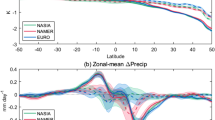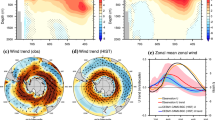Abstract
The effect of ocean mixed layer depth on climate is explored in a suite of slab ocean aquaplanet simulations with different mixed layer depths ranging from a globally uniform value of 50–2.4 m. In addition to the expected increase in the amplitude of the seasonal cycle in temperature with decreasing ocean mixed layer depth, the simulated climates differ in several less intuitive ways including fundamental changes in the annual mean climate. The phase of seasonal cycle in temperature differs non-monotonically with increasing ocean mixed layer depth, reaching a maximum in the 12 m slab depth simulation. This result is a consequence of the change in the source of the seasonal heating of the atmosphere across the suite of simulations. In the shallow ocean runs, the seasonal heating of the atmosphere is dominated by the surface energy fluxes whereas the seasonal heating is dominated by direct shortwave absorption within the atmospheric column in the deep ocean runs. The surface fluxes are increasingly lagged with respect to the insolation as the ocean deepens which accounts for the increase in phase lag from the shallow to mid-depth runs. The direct shortwave absorption is in phase with insolation, and thus the total heating comes back in phase with the insolation as the ocean deepens more and the direct shortwave absorption dominates the seasonal heating of the atmosphere. The intertropical convergence zone follows the seasonally varying insolation and maximum sea surface temperatures into the summer hemisphere in the shallow ocean runs whereas it stays fairly close to the equator in the deep ocean runs. As a consequence, the tropical precipitation and region of high planetary albedo is spread more broadly across the low latitudes in the shallow runs, resulting in an apparent expansion of the tropics relative to the deep ocean runs. As a result, the global and annual mean planetary albedo is substantially (20 %) higher in the shallow ocean simulations which results in a colder (7C) global and annual mean surface temperature. The increased tropical planetary albedo in the shallow ocean simulations also results in a decreased equator-to-pole gradient in absorbed shortwave radiation and drives a severely reduced (≈50 %) meridional energy transport relative to the deep ocean runs. As a result, the atmospheric eddies are weakened and shifted poleward (away from the high albedo tropics) and the eddy driven jet is also reduced and shifted poleward by 15° relative to the deep ocean run.








Similar content being viewed by others
Notes
We note that the seasonal cycle of temperature in the deep runs is delayed aloft in the vicinity of 40°. This phase lag is a consequence of reduced eddy energy flux divergence during the warm season that is driven by extratropical atmospheric heating which leads to a reduced meridional temperature gradient aloft during the late summer. This acts as a phase delayed source of heating in the subtropical troposphere which is driven non-locally
We note that, the seasonal amplitude of extratropical shortwave radiation absorbed at the surface is in phase with the insolation but has 57 % of the seasonal amplitude of the insolation (125 W m−2 as compared to 220 W m−2) which represents the shortwave opacity of the atmosphere times the surface co-albedo (0.92). Thus, in the limit of zero surface heat capacity we would expect that approximately 57 % of the seasonal insolation to enter the atmospheric column via SHF as compared to the 20 % of insolation absorbed directly in the atmospheric column (SWABS). In this case, there is an approximatley 3:1 heating ratio of SHF:SWABS, similar to the observed annual mean ratio (Donohoe and Battisti 2013).
The stationary eddies make a negligible contribution to the total energy transport. The stationary eddy energy transport is included in the eddy energy transport term for completeness.
The equatorward MOC energy transport in the deep tropics of the 50 m run is a consequence of the moist static energy decreasing with height in the boundary layer due to a very moist and warm boundary layer. This results in the Hadley cell transporting energy in the same direction as the meridional flow at the surface.
References
Andrews D, McIntyre M (1976) Planetary waves in horizontal and vertical shear: the generalized eliassen-palm relation and the zonal mean acceleration. J Atmos Sci 33:2031–2048
Chiang J, Friedman A (2012) Extratropical cooling, interhemispheric thermal gradients, and tropical climate change. Annu Rev Earth Planet Sci 40:383–412
Chou M, Lee K (1996) Parameterizations for the absorption of solar radiation by water vapor and ozone. J Atmos Sci 53:1203–1208
Czaja A, Marshall J (2006) The partitioning of poleward heat transport between the atmosphere and the ocean. J Atmos Sci 63:1498–1511
Danabasoglu G, Gent P (2009) Equilibrium climate sensitivity: is it accurate to use a slab ocean model? J Clim 22:2494–2499
Delworth TL, Broccoli AJ, Rosati A, Stouffer RJ, Balaji V, Beesley JA, Cooke WF (2006) Gfdl’s cm2 global coupled climate models. part I: formulation and simulation characteristics. J Clim 19:643–674
Donohoe A (2011) Radiative and dynamic controls of global scale energy fluxes. Ph.D. thesis, University of Washington, p 137
Donohoe A, Battisti D (2012) What determines meridional heat transport in climate models? J Clim 25:3832–3850
Donohoe A, Battisti D (2013) The seasonal cycle of atmospheric heating and temperature
Donohoe A, Marshall J, Ferreira D, McGee D (2013) The relationship between ITCZ location and atmospheric heat transport across the equator: from the seasonal cycle to the last glacial maximum. J Clim 26(11):3597–3618
Edmon HJ, Hoskins B, McIntyre M (1980) Eliassen-palm cross sections for the troposphere. J Atmos Sci 37:2600–2616
Eliassen A, Palm E (1961) On the transfer of energy in staionary mountain waves. Geofys Publ 22(5):1–23
Enderton D, Marshall J (2009) Controls on the total dynamical heat transport of the atmosphere and oceans. J Atmos Sci 66:1593–1611
Fasullo JT, Trenberth KE (2008a) The annual cycle of the energy budget: part 1. Global mean and land-ocean exchanges. J Clim 21:2297–2312
Fasullo JT, Trenberth KE (2008b) The annual cycle of the energy budget: part 2. Meridional structures and poleward transports. J Clim 21:2313–2325
Frierson D, Hwang Y, Fuckar N, Seager R, Kang S, Donohoe A, Maroon E, Liu X, Battisti D (2013) Why does tropical rainfall peak in the northern hemisphere? The role of the oceans meridional overturning circulation. Nature (submitted)
Johanson C, Fu Q (2009) Hadley cell widening: model simulations versus observations. J Clim 22:2713–2725
Kang S, Held I, Frierson D, Zhao M (2008) The response of the ITCZ to extratropical thermal forcing: idealized slab-ocean experiments with a GCM. J Clim 21:3521–3532
Lin SJ (2004) A “vertically lagrangian” finite-volume dynamical core for global models. Mon Weather Rev 132:2293–2307
Lindzen R, Hou A (1988) Hadley circulations of zonally averaged heating centered off the equator. J Atmos Sci 45:2416–2427
North GR (1975) Theory of energy-balance climate models. J Atmos Sci 32:2033–2043
Rose B, Ferreira D (2013) Ocean heat transport and water vapor greenhouse in a warm equable climate: a new look at the low gradient paradox. J Clim (in press)
Schneider EK (1996) A note on the annual cycle of sea surface temperature at the equator. Technical Report. Center for Ocean-Land-Atmosphere Studies, 18 p
Stone P (1978) Constraints on dynamical transports of energy on a spherical planet. Dyn Atmos Oceans 2:123–139
Stone P, Salustri G (1984) Generalization of the quasi-geostrophic eliassen-palm flux to include eddy forcing of condensational heating. J Atmos Sci 41:3527–3535
Trenberth KE, Caron JM (2001) Estimates of meridional atmosphere and ocean heat transports. J Clim 14:3433–3443
Vallis GK (2006) Atmospheric and oceanic fluid dynamics. Cambridge University Press, Cambridge
Wielicki B, Barkstrom B, Harrison E, Lee R, Smith G, Cooper J (1996) Clouds and the earth’s radiant energy system (CERES): An earth observing system experiment. Bull Am Meteorol Soc 77:853–868
Acknowledgments
AD was funded by the NOAA Global Change Postdoctoral Fellowship.
Author information
Authors and Affiliations
Corresponding author
Rights and permissions
About this article
Cite this article
Donohoe, A., Frierson, D.M.W. & Battisti, D.S. The effect of ocean mixed layer depth on climate in slab ocean aquaplanet experiments. Clim Dyn 43, 1041–1055 (2014). https://doi.org/10.1007/s00382-013-1843-4
Received:
Accepted:
Published:
Issue Date:
DOI: https://doi.org/10.1007/s00382-013-1843-4




